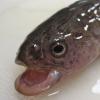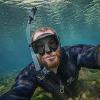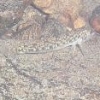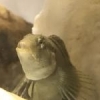
1500 Alaska blackfish between ice layers
#1

Posted 27 January 2015 - 02:00 AM
-Dona Eidam
in Oregon
#2

Posted 27 January 2015 - 03:36 AM
#3

Posted 27 January 2015 - 05:29 AM
How are they between ice layers; did the water freeze solid, then partially thaw from the top down, allowing the fish to move in from deeper holding water before the frozen stuff could thaw all way to the bottom, and then the ice-melt started to refreeze? Or does Alaskan ice just form in ways I can't fathom?
Just one more reason to keep AK on the top of my bucket list destinations. Thanks for posting.
"No thanks, a third of a gopher would merely arouse my appetite..."
#4

Posted 27 January 2015 - 07:15 AM
That many fish; even with reduced metabolic activity must be putting a dent in the oxygen levels of the water.
#5

Posted 27 January 2015 - 08:00 AM
Really appreciate you sharing a look at a part of North American Fishes that most of us will not get a chance to see first hand. Thanks so much.
#6

Posted 27 January 2015 - 12:34 PM
and I imagine those bubbles from the bottom are some mix of CO2, CH4, H2S ... couldn't be helping matters for fish.
I have seen "sunken ice" a few times where a pond level rose (from rainfall or snowmelt) after the ice was frozen.
That many fish; even with reduced metabolic activity must be putting a dent in the oxygen levels of the water.
Gerald Pottern
-----------------------
Hangin' on the Neuse
"Taxonomy is the diaper used to organize the mess of evolution into discrete packages" - M.Sandel
#7

Posted 27 January 2015 - 02:25 PM
That's wild
Josh Blaylock - Central KY
NANFA on Facebook
KYCREEKS - KRWW - KWA
I hope to have God on my side, but I must have Kentucky.
- Abraham Lincoln, 1861
#8

Posted 27 January 2015 - 03:10 PM
Thanks for your comments! The videographer/nordic skater kindly emailed information about the site. I’m not a hydrologist and I too was curious, like Matt, about the overflow conditions we often see here on winter streams:
“I consistently see between 1000 and 1500 apparently mature blackfish typically between the 10th and 20th of January year after year normally after Rabbit Slough floods out and there is a space of water between the old ice surface and new aufeis that’s forming on top. They pack themselves tightly in and don’t seem to be feeding. Undisturbed, they just stay in place. As the water turns to ice the majority of them retreat back under the old ice, and usually a couple dozen get trapped and frozen in, as is the case now. In this spot the slough is quite deep (8'), slow moving, and very soft bottomed peaty mud, surrounded by pretty marshy alders and brush and periodically has open water during the winter.”
By the way, this site (freshwater slough that drains into a salt water inlet) is only 50 miles north of the Anchorage airport, just off a major 6-lane freeway, part of a State Game Refuge, with an easy-access gravel road and parking lot. Any NANFA folks interested in flying to Anchorage, we will meet you and drive you to the site (summer or winter) and show you these cool cool fish! ![]()
-Dona Eidam
in Oregon
#9

Posted 27 January 2015 - 07:23 PM
"No thanks, a third of a gopher would merely arouse my appetite..."
#10

Posted 27 January 2015 - 08:00 PM
The member formerly known as Skipjack
#11

Posted 27 January 2015 - 08:05 PM
Hey Matt, They usually surface in winter to access open holes, to breathe atmospheric air.
Villagers in the Interior cut open an ice hole, set a funnel-shaped trap just below the surface. Blackfish will surface to breathe then dive down into trap. Foxes often gather to eat “floaters” (blackfish sometimes inflate like balloons after overwintering in hypoxic waters--no one has explained what is going on with their physiology here). Folks will watch for holes ringed by fish blood, a sign foxes have located a good hole with abundant blackfish.
-Dona Eidam
in Oregon
#12

Posted 27 January 2015 - 09:20 PM
The member formerly known as Skipjack
#13

Posted 27 January 2015 - 10:14 PM
#14

Posted 28 January 2015 - 06:55 AM
I think you an' me be thinkin' the same things in regards to AK blackfish and OK Red River pupfish...Dona, how warm do the waters they inhabit get during the summer months? I believe I saw some videos you posted a while back of some captive blackfish. I suppose I am asking if they need a chiller? I assume they do, but they are basically big mudminnows, so tough as nails.
"No thanks, a third of a gopher would merely arouse my appetite..."
#15

Posted 28 January 2015 - 12:46 PM
Fascinating video...made me look them up and do some research.
It makes me wonder if someone should get an auger and bore down to the sub surface to let them escape.
It's interesting that on the Alaska DNR site, their PDF about them states that they're easy to catch. They can breath air, and it's a great survival thing, but apparently that can be their downfall. They're a food supply for folks around there, and they cut a hole in the ice in waters where oxygen is lacking, and the fish all swarm to the hole to breath, where they can be easily caught.
I thought that they might be related to burbot, but found out they're in the mudminnow family.
Anyway, thanks for sharing the video Dona! Not only was it a cool video, but I learned some things about a fish that I didn't even know existed before yesterday when I watched the vid. ![]()
Kevin Wilson
#16

Posted 28 January 2015 - 01:12 PM
Hey Matt in Ohio,
Water temperatures for blackfish in the wild can be variable; tundra ponds can get pretty warm.
For our research aquaria, I used chillers to keep temperatures between 12-15 degrees C (about 55-60 degrees F). Some blackfish were in tanks without chillers, at controlled room temperatures (up to 65 degrees F). The fish are happiest at 60 degrees F and cooler. Above 80 degrees is approaching lethal temp for blackfish.
We have to jump through hoops here to apply for research/education collection and aquarium permits to capture and keep any wild fishes in Alaskan waters. ADF&G is a great group of folks working hard to protect our wild salmonids.
-Dona Eidam
in Oregon
#17

Posted 28 January 2015 - 01:25 PM
Chasmodes-thanks! Here’s a photo of a vintage blackfish trap made out of tamarack strips. And Dave Cannon of the Alaska Department of Fish and Game kindly shared two photos of blackfish gulping air at a hole in the ice; you can see remnants of carcasses from foxes feeding around the open hole. This site is a lake somewhere in the Interior.
(Blackfish under these winter conditions are *easy to catch*. When we really need a few for our research tanks, they drive us to drink by avoiding the minnow traps like crazy....)
 vintage minnow trap.jpg 40.18KB
0 downloads
vintage minnow trap.jpg 40.18KB
0 downloads
 BLK FISH2008 Feb Fox Remnents dcannon.jpg 92.69KB
0 downloads
BLK FISH2008 Feb Fox Remnents dcannon.jpg 92.69KB
0 downloads
 BLK FISH2008 Feb Guulping Air dcannon.jpg 96.16KB
0 downloads
BLK FISH2008 Feb Guulping Air dcannon.jpg 96.16KB
0 downloads
-Dona Eidam
in Oregon
#18

Posted 28 January 2015 - 03:01 PM
Fascinating!
Kevin Wilson
#19

Posted 28 January 2015 - 04:00 PM
The member formerly known as Skipjack
#20

Posted 29 January 2015 - 06:41 AM
Road trip! I'll fire up the Mailslinger-Finchaser 2000 (aka Dodge Caravan Custom Mail Delivery and Fish Collecting Vehicle, or DCCMDFCV for short)and we're on it! Just so long as you can get my boss to approve the necessary 5 month leave!I need them.
"No thanks, a third of a gopher would merely arouse my appetite..."
0 user(s) are reading this topic
0 members, 0 guests, 0 anonymous users
















